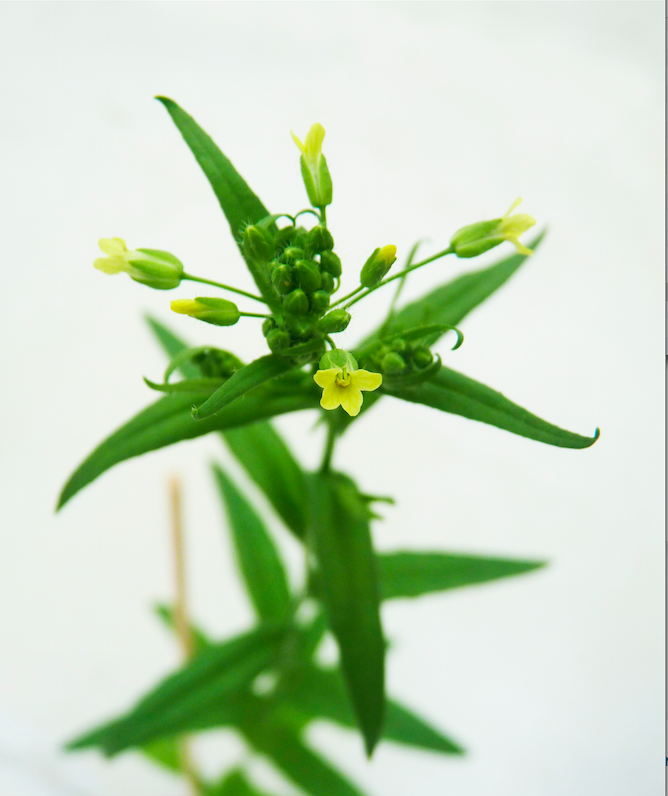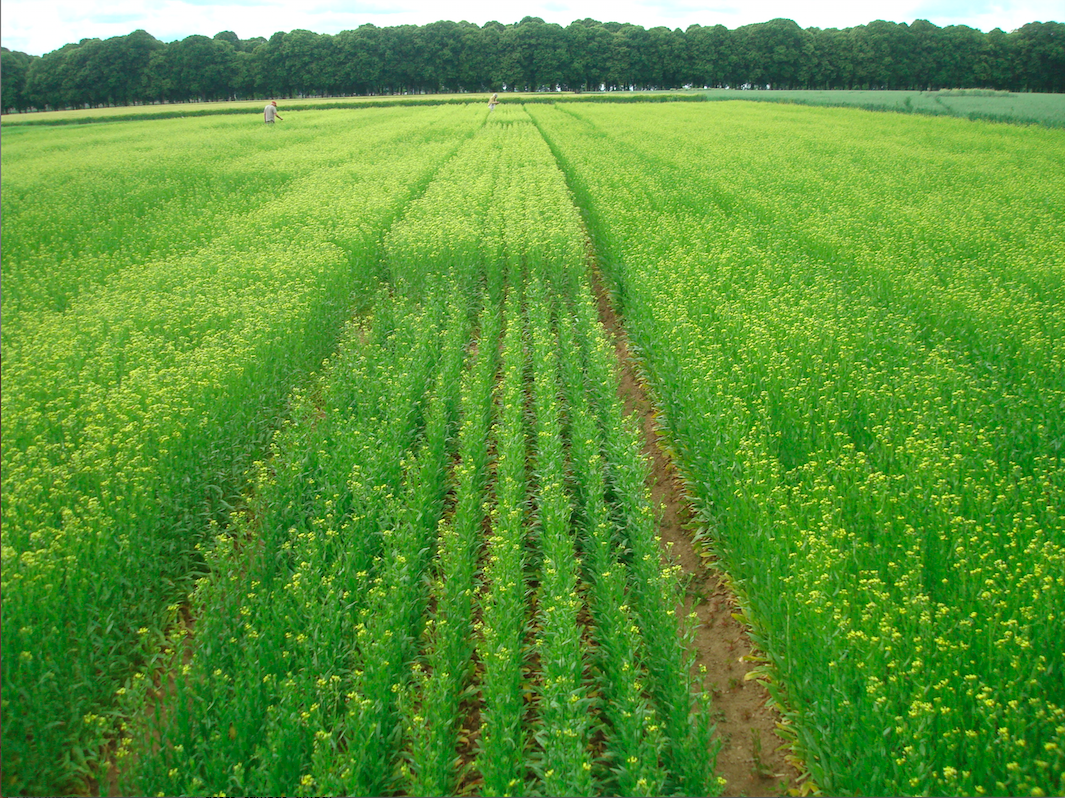Camelina, an ancient oilseed crop and a model for translational research
The DIPOL group has developed several research projects in translational research to develop a new model of oilseed cultivation in the context of a more sustainable agriculture. Camelina sativa is an ancient European oilseed species with an oil profile rich in polyunsaturated fatty acids that can be grown under a wide range of conditions due to its high tolerance to abiotic and biotic stresses. Current projects focus on modifying lipid accumulation in oil, shortening flowering time and resistance to water stress.
conditions due to its high tolerance to abiotic and biotic stresses. Current projects focus on modifying lipid accumulation in oil, shortening flowering time and resistance to water stress.
Designing new oil profiles in Camelina
The impact of polyunsaturated fatty acid reduction on plant development and stress response is of importance in the frame of climatic change. Synthetic biology approaches are also underway to channel specific fatty acids into the oil. These are innovative strategies combining CRISPR multiplex metabolism enhancement and synthetic enzyme assembly. New combinations of enzymes and mutants are now being tested to obtain a wide range of oil profiles. The main objective is to produce camelina plants with fatty acid profiles for new uses with adapted lipids.
Designing early flowering Camelina plants. The short life cycle of camelina opens up particularly interesting possibilities for double cropping that would have positive agro-ecological benefits: e.g. reducing soil erosion; increasing agrobiodiversity. A combination of traditional breeding and CRISPR mutagenesis approaches has identified several new early flowering camelina lines are being evaluated under various growing conditions (Bellec et al. 2022) (DIPOL_image3).
Understanding water stress resistance in camelina. This project is conducted in the framework of a European consortium UNTWIST which aims to characterize the mechanisms of drought tolerance using genetic diversity observed in camelina and multi-omics approaches in controlled and field conditions. The project aims to develop predictive models and biomarkers associated with this tolerance. Our team will also contribute to increase this genetic diversity by developing new recombinant lines that will allow to validate the models.

Regulation of localized lipid metabolism in the endoplasmic reticulum and stress tolerance
In eukaryotic cells, the endoplasmic reticulum (ER) is the site of synthesis, folding and maturation of the majority of secreted proteins, whether soluble or membrane-bound; it accounts for nearly one-third of the cell's proteins. It is also at the level of this organelle that the synthesis and modification of several families of lipids take place, such as very long-chain fatty acids, phospholipids, sphingolipids or the triglycerides that make up oils. In plant cells, the coordination of these two types of metabolism (lipid and protein) ensures the homeostasis of the ER. In this context, we are interested in the impact of biotic and abiotic stresses on the regulation of ER protein and lipid biosynthesis and are seeking to understand them using the Arabidopsis thaliana model. Conversely, we use mutants with a loss of protein or lipid homeostasis to understand the role of these metabolic changes in stress tolerance.
Lipid droplet engineering
Over the last 20 years, research on lipid droplets (LD) has been booming. Indeed, the dysfunction of these cellular organelles is associated with diseases such as diabetes, myopathies, hepatic steatosis or viral infections. Moreover, the lipids contained in LDs are important molecules for food (vegetable oils), green chemistry (biodiesel) and cosmetics (soaps, creams containing vegetable oils).
These LDs, mainly composed of lipids, also contain proteins on their surface. Some key points of the LD biogenesis process remain poorly understood including (1) the mechanisms of geolocalization and assembly of LD formation sites within the ER and (2) the structural changes and protein domains allowing the passage of proteins from the ER membrane bilayer to the GL phospholipid monolayer. The team, in collaboration with Core Biogenesis, develops functionalized camelina LDs for protein production and delivery. Indeed, the use of seed LDs for the production of recombinant proteins or for vectorization is illustrated in the scientific literature or through patents. The production of recombinant proteins associated with seed LDs has many advantages including (1) the absence of pathogens and molecules of animal or bacterial origin in the samples, (2) the seed as a natural storage system at low cost (natural desiccation, protection against oxidation, no cold chain, etc.) (3) plant fractions for transcutaneous or oral vectorization. The association of recombinant proteins at the surface of LDs allows a purification of the products of interest by aqueous extraction and flotation, which is more respectful of the environment and of the products of interest than some conventional technologies for protein production using denaturing products, detergents, solvents or a heating step. This technology requires obtaining in planta a good association of proteins with LD. For this, a thorough knowledge and control of the cellular mechanisms of addressing and association on the surface of LDs is necessary
The DIPOL group has developed several research projects in translational research to develop a new model of oilseed cultivation in the context of a more sustainable agriculture. Camelina sativa is an ancient European oilseed species with an oil profile rich in polyunsaturated fatty acids that can be grown under a wide range of
 conditions due to its high tolerance to abiotic and biotic stresses. Current projects focus on modifying lipid accumulation in oil, shortening flowering time and resistance to water stress.
conditions due to its high tolerance to abiotic and biotic stresses. Current projects focus on modifying lipid accumulation in oil, shortening flowering time and resistance to water stress.Designing new oil profiles in Camelina
The impact of polyunsaturated fatty acid reduction on plant development and stress response is of importance in the frame of climatic change. Synthetic biology approaches are also underway to channel specific fatty acids into the oil. These are innovative strategies combining CRISPR multiplex metabolism enhancement and synthetic enzyme assembly. New combinations of enzymes and mutants are now being tested to obtain a wide range of oil profiles. The main objective is to produce camelina plants with fatty acid profiles for new uses with adapted lipids.
Designing early flowering Camelina plants. The short life cycle of camelina opens up particularly interesting possibilities for double cropping that would have positive agro-ecological benefits: e.g. reducing soil erosion; increasing agrobiodiversity. A combination of traditional breeding and CRISPR mutagenesis approaches has identified several new early flowering camelina lines are being evaluated under various growing conditions (Bellec et al. 2022) (DIPOL_image3).
Understanding water stress resistance in camelina. This project is conducted in the framework of a European consortium UNTWIST which aims to characterize the mechanisms of drought tolerance using genetic diversity observed in camelina and multi-omics approaches in controlled and field conditions. The project aims to develop predictive models and biomarkers associated with this tolerance. Our team will also contribute to increase this genetic diversity by developing new recombinant lines that will allow to validate the models.

Regulation of localized lipid metabolism in the endoplasmic reticulum and stress tolerance
In eukaryotic cells, the endoplasmic reticulum (ER) is the site of synthesis, folding and maturation of the majority of secreted proteins, whether soluble or membrane-bound; it accounts for nearly one-third of the cell's proteins. It is also at the level of this organelle that the synthesis and modification of several families of lipids take place, such as very long-chain fatty acids, phospholipids, sphingolipids or the triglycerides that make up oils. In plant cells, the coordination of these two types of metabolism (lipid and protein) ensures the homeostasis of the ER. In this context, we are interested in the impact of biotic and abiotic stresses on the regulation of ER protein and lipid biosynthesis and are seeking to understand them using the Arabidopsis thaliana model. Conversely, we use mutants with a loss of protein or lipid homeostasis to understand the role of these metabolic changes in stress tolerance.
Lipid droplet engineering
Over the last 20 years, research on lipid droplets (LD) has been booming. Indeed, the dysfunction of these cellular organelles is associated with diseases such as diabetes, myopathies, hepatic steatosis or viral infections. Moreover, the lipids contained in LDs are important molecules for food (vegetable oils), green chemistry (biodiesel) and cosmetics (soaps, creams containing vegetable oils).
These LDs, mainly composed of lipids, also contain proteins on their surface. Some key points of the LD biogenesis process remain poorly understood including (1) the mechanisms of geolocalization and assembly of LD formation sites within the ER and (2) the structural changes and protein domains allowing the passage of proteins from the ER membrane bilayer to the GL phospholipid monolayer. The team, in collaboration with Core Biogenesis, develops functionalized camelina LDs for protein production and delivery. Indeed, the use of seed LDs for the production of recombinant proteins or for vectorization is illustrated in the scientific literature or through patents. The production of recombinant proteins associated with seed LDs has many advantages including (1) the absence of pathogens and molecules of animal or bacterial origin in the samples, (2) the seed as a natural storage system at low cost (natural desiccation, protection against oxidation, no cold chain, etc.) (3) plant fractions for transcutaneous or oral vectorization. The association of recombinant proteins at the surface of LDs allows a purification of the products of interest by aqueous extraction and flotation, which is more respectful of the environment and of the products of interest than some conventional technologies for protein production using denaturing products, detergents, solvents or a heating step. This technology requires obtaining in planta a good association of proteins with LD. For this, a thorough knowledge and control of the cellular mechanisms of addressing and association on the surface of LDs is necessary

Leader:
Jean-Denis Faure